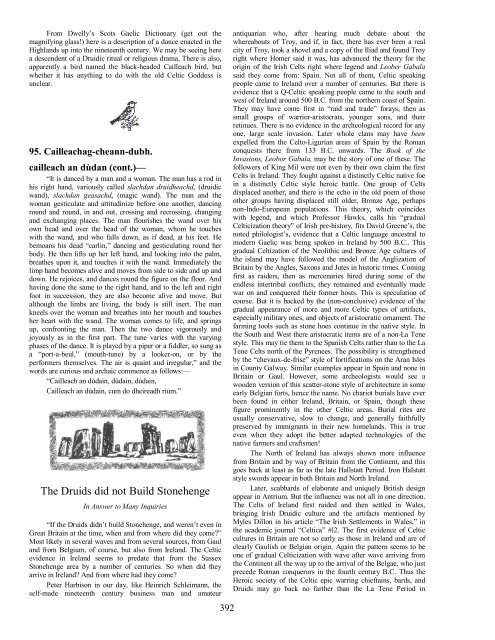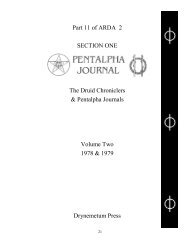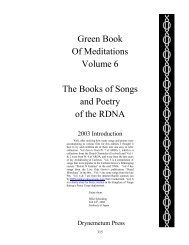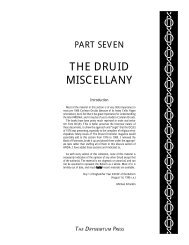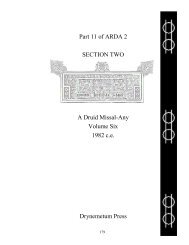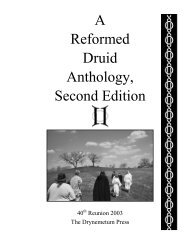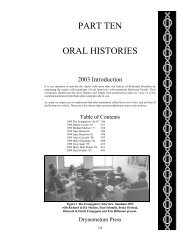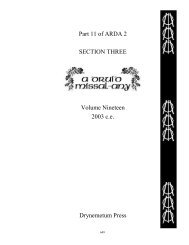Part 11 of ARDA 2 SECTION TWO A - Student Organizations ...
Part 11 of ARDA 2 SECTION TWO A - Student Organizations ...
Part 11 of ARDA 2 SECTION TWO A - Student Organizations ...
You also want an ePaper? Increase the reach of your titles
YUMPU automatically turns print PDFs into web optimized ePapers that Google loves.
From Dwelly’s Scots Gaelic Dictionary (get out the<br />
magnifying glass!) here is a description <strong>of</strong> a dance enacted in the<br />
Highlands up into the nineteenth century. We may be seeing here<br />
a descendent <strong>of</strong> a Druidic ritual or religious drama, There is also,<br />
apparently a bird named the black-headed Cailleach bird, but<br />
whether it has anything to do with the old Celtic Goddess is<br />
unclear.<br />
95. Cailleachag-cheann-dubh.<br />
cailleach an dùdan (cont.)—<br />
“It is danced by a man and a woman. The man has a rod in<br />
his right hand, variously called slachdan druidheachd, (druidic<br />
wand), slachdan geasachd, (magic wand). The man and the<br />
woman gesticulate and attitudinize before one another, dancing<br />
round and round, in and out, crossing and recrossing, changing<br />
and exchanging places. The man flourishes the wand over his<br />
own head and over the head <strong>of</strong> the woman, whom he touches<br />
with the wand, and who falls down, as if dead, at his feet. He<br />
bemoans his dead “carlin,” dancing and gesticulating round her<br />
body. He then lifts up her left hand, and looking into the palm,<br />
breathes upon it, and touches it with the wand. Immediately the<br />
limp hand becomes alive and moves from side to side and up and<br />
down. He rejoices, and dances round the figure on the floor. And<br />
having done the same to the right hand, and to the left and right<br />
foot in succession, they are also become alive and move. But<br />
although the limbs are living, the body is still inert. The man<br />
kneels over the woman and breathes into her mouth and touches<br />
her heart with the wand. The woman comes to life, and springs<br />
up, confronting the man. Then the two dance vigorously and<br />
joyously as in the first part. The tune varies with the varying<br />
phases <strong>of</strong> the dance. It is played by a piper or a fiddler, so sung as<br />
a “port-a-beul,” (mouth-tune) by a looker-on, or by the<br />
performers themselves. The air is quaint and irregular,” and the<br />
words are curious and archaic commence as follows:—<br />
“Cailleach an dùdain, dùdain, dùdain,<br />
Cailleach an dùdain, cum do dheireadh rium.”<br />
The Druids did not Build Stonehenge<br />
In Answer to Many Inquiries<br />
“If the Druids didn’t build Stonehenge, and weren’t even in<br />
Great Britain at the time, when and from where did they come”<br />
Most likely in several waves and from several sources, from Gaul<br />
and from Belgium, <strong>of</strong> course, but also from Ireland. The Celtic<br />
evidence in Ireland seems to predate that from the Sussex<br />
Stonehenge area by a number <strong>of</strong> centuries. So when did they<br />
arrive in Ireland And from where had they come<br />
Peter Harbison in our day, like Heinrich Schleimann, the<br />
self-made nineteenth century business man and amateur<br />
392<br />
antiquarian who, after hearing much debate about the<br />
whereabouts <strong>of</strong> Troy, and if, in fact, there has ever been a real<br />
city <strong>of</strong> Troy, took a shovel and a copy <strong>of</strong> the Iliad and found Troy<br />
right where Homer said it was, has advanced the theory for the<br />
origin <strong>of</strong> the Irish Celts right where legend and Leober Gabala<br />
said they come from: Spain. Not all <strong>of</strong> them, Celtic speaking<br />
people came to Ireland over a number <strong>of</strong> centuries. But there is<br />
evidence that a Q-Celtic speaking people came to the south and<br />
west <strong>of</strong> Ireland around 500 B.C. from the northern coast <strong>of</strong> Spain.<br />
They may have come first in “raid and trade” forays, then as<br />
small groups <strong>of</strong> warrior-aristocrats, younger sons, and their<br />
retinues. There is no evidence in the archeological record for any<br />
one, large scale invasion. Later whole clans may have been<br />
expelled from the Celto-Ligurian areas <strong>of</strong> Spain by the Roman<br />
conquests there from 133 B.C. onwards. The Book <strong>of</strong> the<br />
Invasions, Leobor Gabala, may be the story <strong>of</strong> one <strong>of</strong> these. The<br />
followers <strong>of</strong> King Mil were not even by their own claim the first<br />
Celts in Ireland. They fought against a distinctly Celtic native foe<br />
in a distinctly Celtic style heroic battle. One group <strong>of</strong> Celts<br />
displaced another, and there is the echo in the old poem <strong>of</strong> those<br />
other groups having displaced still older, Bronze Age, perhaps<br />
non-Indo-European populations. This theory, which coincides<br />
with legend, and which Pr<strong>of</strong>essor Hawks, calls his “gradual<br />
Celticization theory” <strong>of</strong> Irish pre-history, fits David Greene’s, the<br />
noted philologist’s, evidence that a Celtic language ancestral to<br />
modern Gaelic was being spoken in Ireland by 500 B.C.. This<br />
gradual Celtization <strong>of</strong> the Neolithic and Bronze Age cultures <strong>of</strong><br />
the island may have followed the model <strong>of</strong> the Anglization <strong>of</strong><br />
Britain by the Angles, Saxons and Jutes in historic times. Coming<br />
first as raiders, then as mercenaries hired during some <strong>of</strong> the<br />
endless intertribal conflicts, they remained and eventually made<br />
war on and conquered their former hosts. This is speculation <strong>of</strong><br />
course. But it is backed by the (non-conclusive) evidence <strong>of</strong> the<br />
gradual appearance <strong>of</strong> more and more Celtic types <strong>of</strong> artifacts,<br />
especially military ones, and objects <strong>of</strong> aristocratic ornament. The<br />
farming tools such as stone hoes continue in the native style. In<br />
the South and West there aristocratic items are <strong>of</strong> a non-La Tene<br />
style. This may tie them to the Spanish Celts rather than to the La<br />
Tene Celts north <strong>of</strong> the Pyrenees. The possibility is strengthened<br />
by the “chevaux-de-frise” style <strong>of</strong> fortifications on the Aran Isles<br />
in County Galway. Similar examples appear in Spain and none in<br />
Britain or Gaul. However, some archeologists would see a<br />
wooden version <strong>of</strong> this scatter-stone style <strong>of</strong> architecture in some<br />
early Belgian forts, hence the name. No chariot burials have ever<br />
been found in either Ireland, Britain, or Spain, though these<br />
figure prominently in the other Celtic areas. Burial rites are<br />
usually conservative, slow to change, and generally faithfully<br />
preserved by immigrants in their new homelands. This is true<br />
even when they adopt the better adapted technologies <strong>of</strong> the<br />
native farmers and craftsmen!<br />
The North <strong>of</strong> Ireland has always shown more influence<br />
from Britain and by way <strong>of</strong> Britain from the Continent, and this<br />
goes back at least as far as the late Hallstatt Period. Iron Halstatt<br />
style swords appear in both Britain and North Ireland.<br />
Later, scabbards <strong>of</strong> elaborate and uniquely British design<br />
appear in Antrium. But the influence was not all in one direction.<br />
The Celts <strong>of</strong> Ireland first raided and then settled in Wales,<br />
bringing Irish Druidic culture and the artifacts mentioned by<br />
Myles Dillon in his article “The Irish Settlements in Wales,” in<br />
the academic journal “Celtica” #l2. The first evidence <strong>of</strong> Celtic<br />
cultures in Britain are not so early as those in Ireland and are <strong>of</strong><br />
clearly Gaulish or Belgian origin. Again the pattern seems to be<br />
one <strong>of</strong> gradual Celticization with wave after wave arriving from<br />
the Continent all the way up to the arrival <strong>of</strong> the Belgae, who just<br />
precede Roman conquerors in the fourth century B.C. Thus the<br />
Heroic society <strong>of</strong> the Celtic epic warring chieftains, bards, and<br />
Druids may go back no farther than the La Tene Period in


